Overnight New York Style Bagels
These bagels are chewy, crusty and properly dense New York Style Bagels. The overnight rise creates the perfect texture and flavor – and you’ll have fresh, hot bagels for breakfast or brunch less than an hour after getting out of bed.
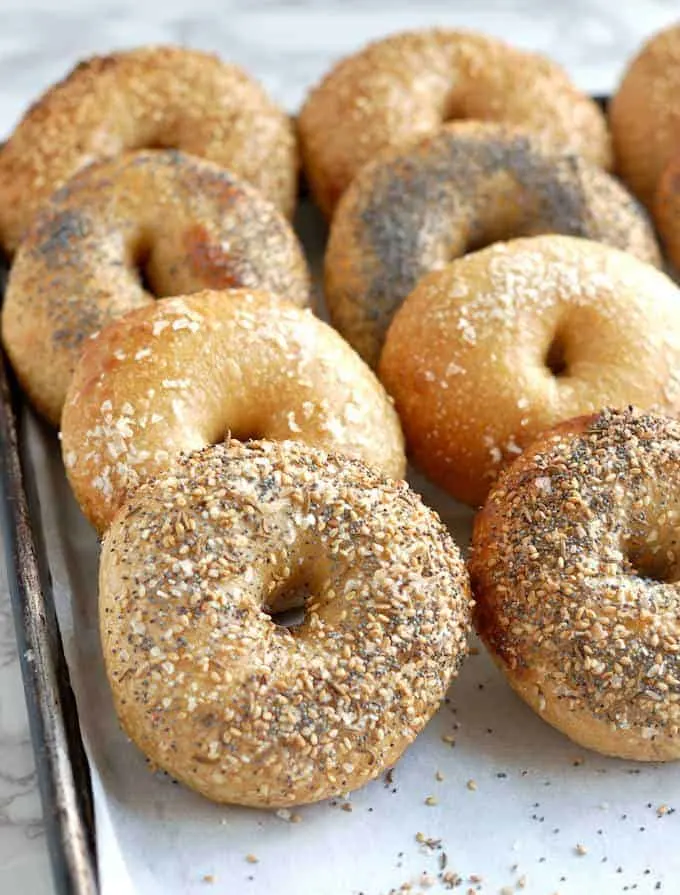
What is a true New York Style Bagel?
I promise you if you follow this recipe correctly you can make a good bagel at home. I mean, there are loads of really bad bagels in the world and life is just too short to eat a bad bagel.
Like a really great loaf of Rye Bread there’s nothing like a true New York style bagel.
A good New York Style Bagel (really, is there any other kind?) must have a nicely dense and chewy texture with a toothsome crust.
To get that characteristic chewiness we’ve got to develop some really strong gluten in the dough.
If you love baking bread and want to understand the process a little better, take a look at comprehensive Bread Baking Guide. It covers the basics of mixing, kneading, proofing, and baking so you can get perfect results every time.
If you’ve got a sourdough starter, you can make Homemade Sourdough Bagels .
Ingredients
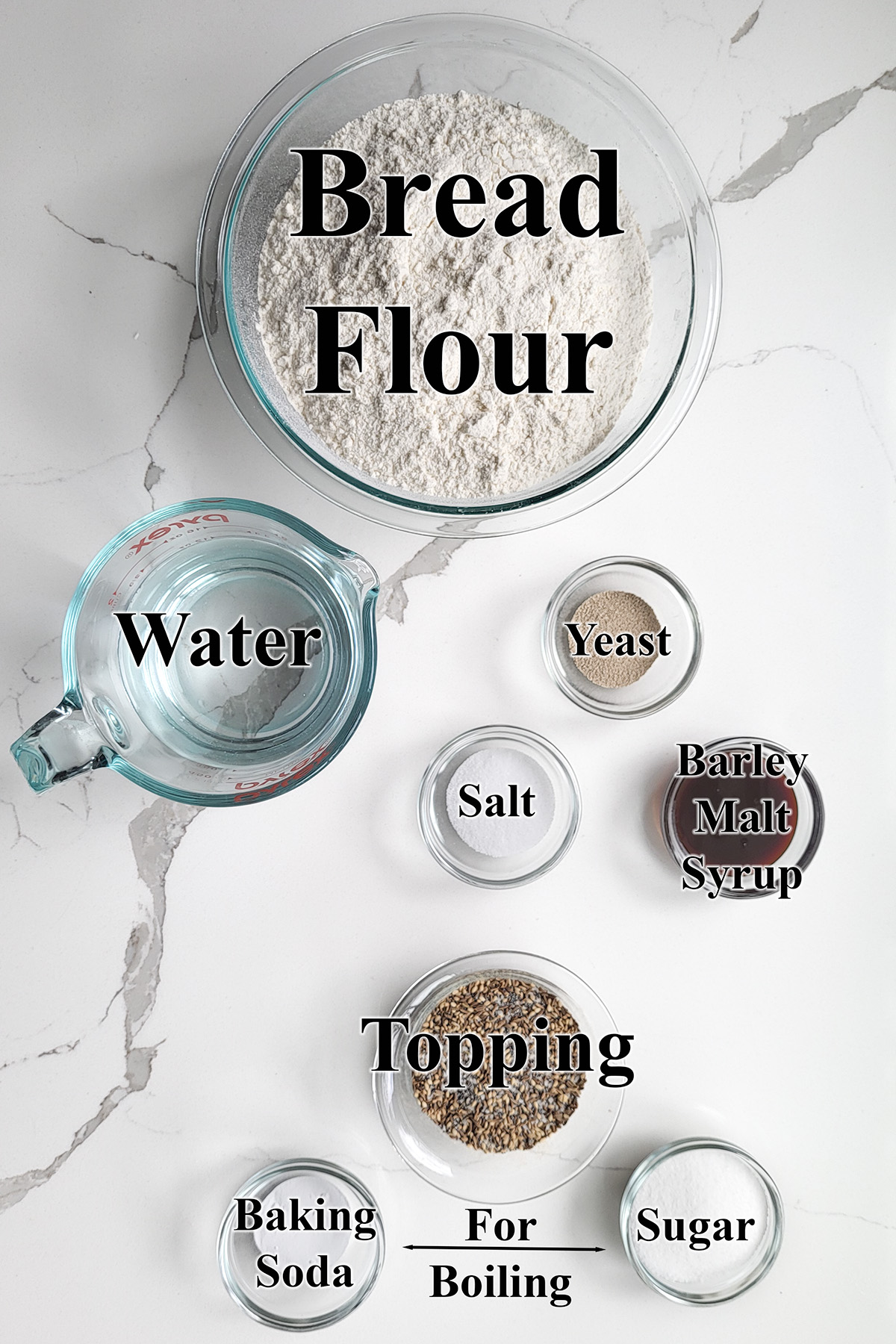
Ingredient Notes
- Bread Flour – Bagels should have a very chewy crumb from a strong gluten network in the dough. High protein bread flour develops plenty of gluten.
- Yeast – I prefer instant yeast to rapid rise yeast for a slightly slower rise. A slow overnight rise gives more time for flavor to develop.
- Barley Malt Syrup – Adds a traditional slightly sweet note to the dough. You can substitute honey or a combination or honey and molasses for the barley malt syrup.
- Toppings – Leave the bagels plain or use your favorite seed for topping. You can mix seeds with salt to make your own “everything” bagel topping”. See the recipe card for details.
- Baking Soda & Sugar – For boiling the bagels. The boiling process creates the specific shiny and chewy bagel crust.
How to make New York style Bagels
See the recipe card for detailed measurements and instructions.
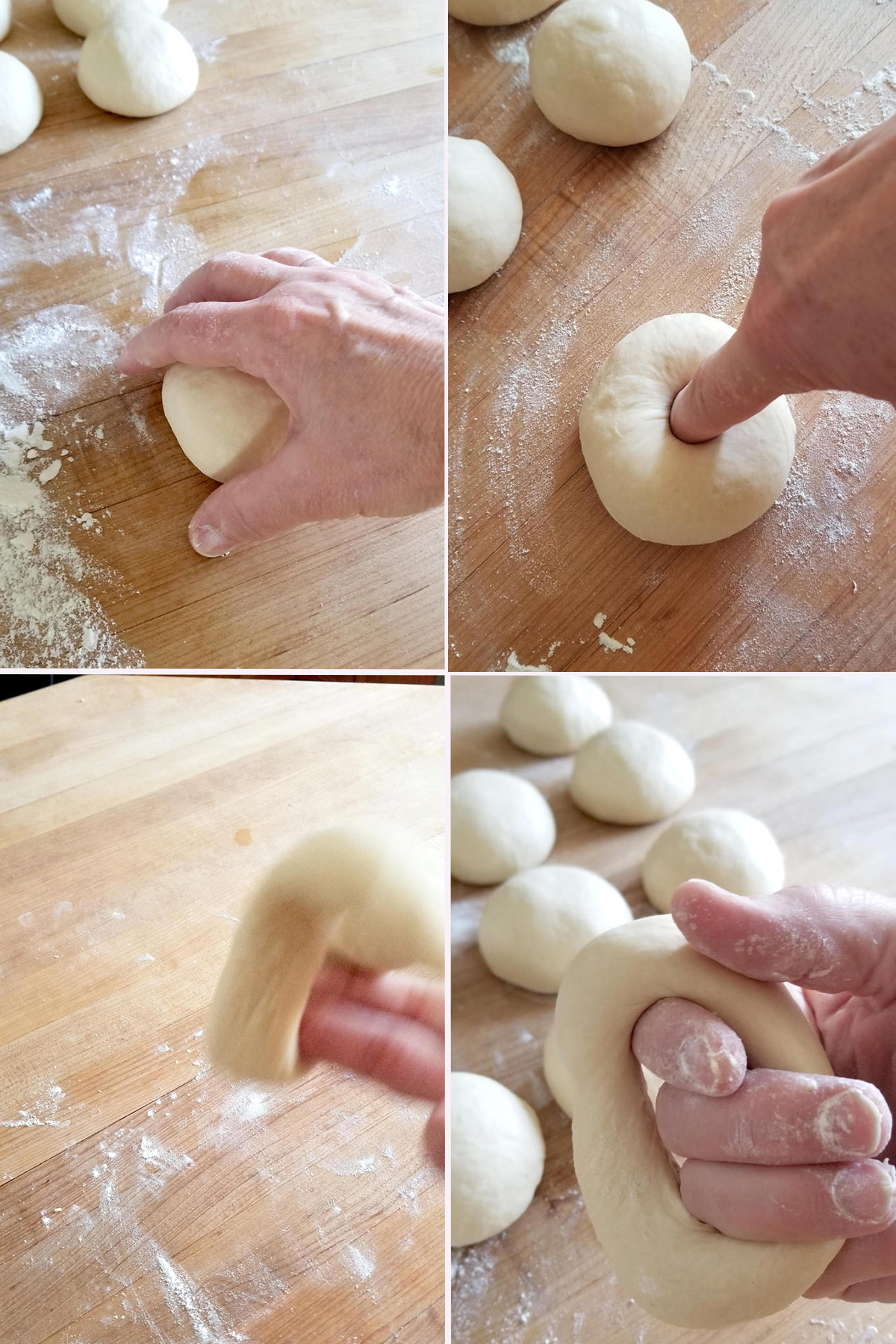
- Use a cupped hand to form the a piece of dough into a smooth ball.
- Poke your finger all the way through the center of the ball to make a hole.
- Twirl the dough around your fingers to widen the center hole.
- Set the bagel onto the baking sheet and continue with the rest of the dough.
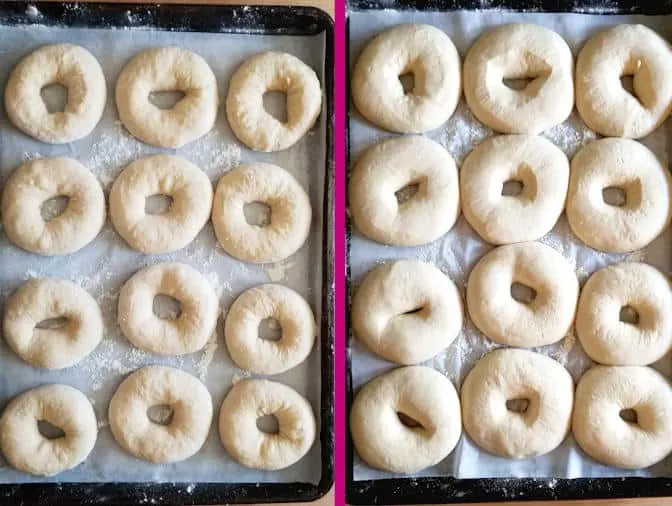
- Cover the pan and place the bagels in the refrigerator overnight.
- If you want to make the bagels the same day set them aside at room temperature for 1 hour.
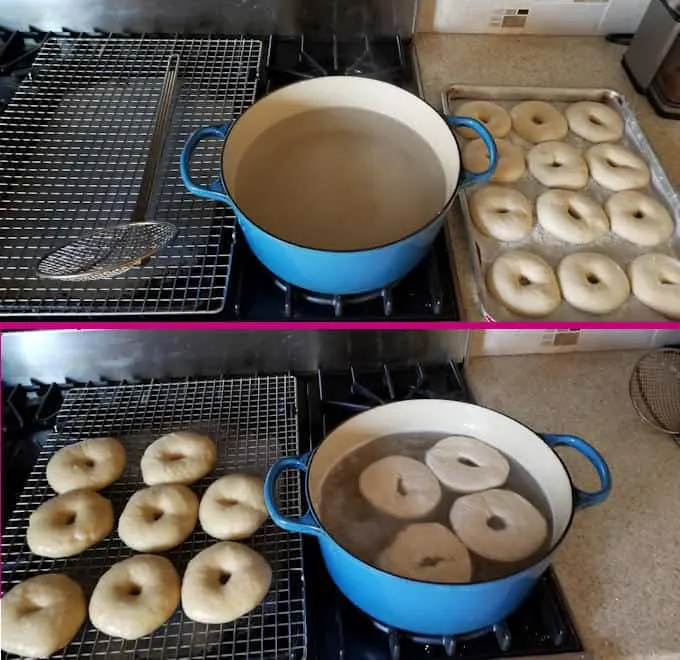
- Bring a pot of water with baking soda and sugar to a boil. Preheat the oven.
- Boil the bagels a few at a time, flipping them every thirty seconds. Boil each batch for 2 minutes.
- Transfer the bagels to a rack to drain while you finish boiling the rest of the bagels.
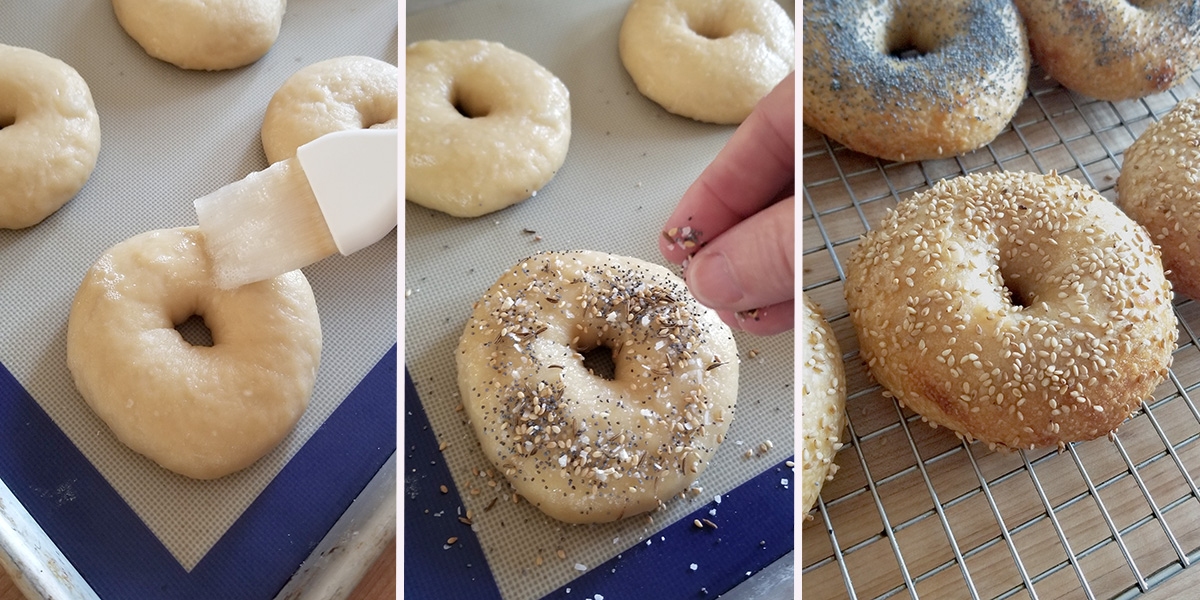
- Brush the boiled bagels with egg white.
- Sprinkle seeds or bagel topping if desired.
- Bake until the bagels are golden brown.
Recipe Tips
- Allow the sponge to rest for 30 minutes before mixing the dough. During that rest the water has time to hydrate the flour and gives us a head start on gluten develop.
- To make the bagels the same day, skip the overnight rise in the refrigerator.
- Bagels are best the day they are baked. For longer term storage slice the bagels about 3/4 the way through and pack them into freezer bags.
- Previously frozen bagels are best if toasted before serving.

You might also like to try these Cinnamon Raisin Bagels.
If you love this recipe as much as I do, I’d really appreciate a star rating and a quick comment. Ratings and comments help my recipes show in search results. Thanks!
Overnight Bagel Recipe
Ingredients
- 16 oz warm water (2 cups (about 100°F))
- ¼ oz instant yeast (2 ¼ teaspoons)
- 25 oz bread flour (5 cups, divided, see note)
- 1 ½ oz barley malt syrup ( 2 tablespoons, see note)
- 1 tablespoon table salt
- 2 oz granulated sugar (¼ cup (for boiling))
- 2 teaspoons baking soda (for boiling)
- 1 egg white (whisked lightly)
- Topping (Sesame seeds, poppy seeds, caraway seeds or coarse sea salt)
Instructions
- In a bowl for a stand mixer or a large mixing bowl combine 16 oz warm water, ¼ oz instant yeast and 3 cups (15 oz) of the flour . Mix to form a thick batter. Cover the bowl and set aside for 30-60 minutes.
- Add 1 ½ oz barley malt syrup and 1 tablespoon table salt. If using a stand mixer, switch to the dough hook. Add the remaining flour and mix to combine. Knead 5 minutes on medium/low speed. If working by hand, stir in as much of the flour as you can, then turn the dough out onto a lightly floured surface and knead in the remaining flour. Knead 5 minutes. Form the dough into a smooth ball.
- Put the dough into a lightly oiled bowl, turning once to coat the dough. Cover the bowl and set aside to rise until doubled in size, about 1 hour.
- Line a half sheet pan with parchment paper lightly sprinkled with flour or sprinkle the pan generously with cornmeal. Turn the dough out onto a lightly floured surface and knead briefly. Divide the dough into 10 even pieces. Use a cupped hand to roll each piece into a smooth, tight ball.
- To form a bagel, poke your finger all the way through the center of a ball to make a hole. Use two fingers to gently widen the hole. Continue gently stretching to form the bagel or twirl the dough around your fingers to widen the center hole (see photos). The hole should be 1 – 1 ½" wide.
- Place the bagel on the prepared sheet pan and continue to form the remaining bagels. The dough will probably spring back a bit so you can go back and re-stretch them once you're done forming all the bagels. Cover the pan with lighly oiled plastic wrap and leave at room temperature for 15 minutes then place the pan in the refrigerator overnight.
- In the morning, take the pan out of the refrigerator. The bagels should be noticeably fuller. Leave the tray out until the bagels come to room temperature, about 1 – 1 ½ hours. The time will vary based on the temperature in the room and how much the dough rose in the refrigerator. Once the dough comes to room temperature the bagels are ready to boil.
- Meanwhile, preheat the oven to 450 °F. In a large pot combine 1 gallon of water with 2 oz granulated sugar and 2 teaspoons baking soda and bring it to a boil. Reduce the heat to keep the water at a rolling simmer. Set a cooling rack over a clean sheet pan and place it next to the stove.
- Lift a bagel off the sheet pan and lower it into the boiling water, bottom side down. Depending on the size of your pot, you can boil 3-4 bagels at a time. Boil the bagels for 30 seconds then flip them. Boil the other side for 30 seconds. Repeat the process again for a total of 2 minutes boiling time. Remove the boiled bagels from the water and set them on the cooling rack to drain.
- Line two half-sheet pans with parchment paper or silicone baking mats and generously sprinkle with cornmeal (or flour). Place 5 of the boiled bagels on each sheet pan. You could fit them all on one pan but they may rise enough to stick together as they bake. I like all the sides to be crusty so I leave plenty of room between them.
- Brush the bagels with egg white. You can leave the bagels plain or add the topping of your choice. To make "everything" bagels combine a tablespoon of each of sesame seeds, poppy seeds & salt with a 1/8 teaspoon garlic powder and onion powder. Adjust toppings to your taste.
- Bake until golden brown, about 20 minutes.
Would you like to save this recipe?
As an Amazon Associate and member of other affiliate programs, I earn from qualifying purchases.









These were the best bagels I’ve made in recent memory. I made this first batch plain, since seeds hide a multitude of problems and I wanted to taste and see what they were actually like. That sponge may have been key in how flavorful they were. Excellent warm out of the oven; and the split/wrapped/frozen ones taste great and have a nice chew after toasting. But the crust itself was a bit chewier than I was expecting, perhaps since I had to knead them a little longer. The dough was quite wet and sticky when I was almost at the end of kneading in my stand mixer, and had to add an extra cup of flour in total, which may have made the crust more obstinate. My bread flour was 13.3% PRO. The temps here are 65-70F indoors, 60-ish outside. It hadn’t been raining excessively and humidity is ~50% (if it WERE muggy, baking is the last thing I’d be doing). I’d measured most ingredients by weight, and the H2O by ml/cups. My measurements were as correct as I could make them. So, I’m curious why my dough was as wet as it was, as it seems like if it were due to the protein in the flour, it should have been drier, not wetter? That said, I’ll make these again once we’re done with the ones in the freezer. Coatings of sesame seed and poppy seed are next on the menu, now that I know they have nothing to hide.
Just finished making these bagels, had no problems at all. I followed the recipe the only thing I did different was that I knead it for almost 7 minutes. Would make again.
So for everyone having trouble with their bagels deflating. There could be a few reasons. I’ll list them and also give tips on how to fix it.
1.) Check the temperature of your refrigerator. Make sure that the thermostat is set at the right number.
*Place your tray of bagels at the very bottom of the fridge. It’s the coldest part. Try not to open the fridge so much while these are fermenting. Every time you open the door it takes about an hour for your fridge to bounce back.
2.) Reduce the amount of yeast called for in the recipe.
*When fermenting dough overnight in the refrigerator it’s best to only use about a third of the amount that the recipe calls for. Why? Well since the dough will be proving for a long period of time, you don’t want the yeast to work to quickly. The more yeast the faster the dough becomes over proofed. Not only will the dough lose its shape it can also start to smell and taste like alcohol due to the yeast consuming all the starch. I recommend about 2 grams of yeast for this recipe.
3.) Check the temperature of the water.
*Lower the H2O temperature to about 66-68 degrees. (Depending on the temp of your house. The warmer the kitchen the more cold your water should be. A loe temperature water guarantees your dough to rise slower. Thus preventing over proofed bagels.
Thank you. Let me know if this helps any.
AJB
The dough was very sticky, so I needed to add an extra 1/2 cup flour. I was able to form them easily and they rose perfectly overnight. However, when I placed them in the boiling water, they got all wrinkly and deflated. Does anyone know why that might have happened?
5 cups of bread flour is not 705g. What is the correct amount of flour?
That’s pretty definitive statement. Why are you so sure that 5 cups of bread flour is not 705g? If you assume my number is wrong you must believe you know the correct number. If you really are asking I will tell you how I got that number. The weight of a cup of flour is not an absolute. The way you fill the cup will determine the exact weight of the flour in the cup. I always fill a measuring cup using the “dip and sweep” method. That is, I dip the cup into the bin to overfill it. I sweep away the excess flour. Using this method I consistently get very, very close to 5 oz per cup (25 oz total in this recipe). There are 28.3g per ounce. 25ozx28.3=707. I rounded the number from 707 down to 705g.
@Eileen Gray, Hi Eileen, I apologize if my wording bothered you. I assumed measurment was taken with standard practice for flour which is keeping it “fluffy” not compacting. A cup of flour is about 120 g which if measured with 5 cups is only 600g. That being said I needed more than 705g, which is why I think most people have difficulty with consistency of dough in this recipe.
Tone can be difficult in written communication. I’m not being snarky when I say that, as a pastry chef for 30 years and with a culinary degree, there is no “standard” practice for measuring dry ingredients by volume. My standard practice is to dip and sweep since I find it much easier and faster than fluffing and spooning flour into the cup. I recommend using the weight measurements of any recipe as that is always more accurate for exactly this reason. I wouldn’t say most people have difficulty with the consistency of this dough. With over 200 reviews and over 120 comments I saw about 4-5 folks mentioning wet dough. Again, this could be due to using volume measure rather than weight measure.